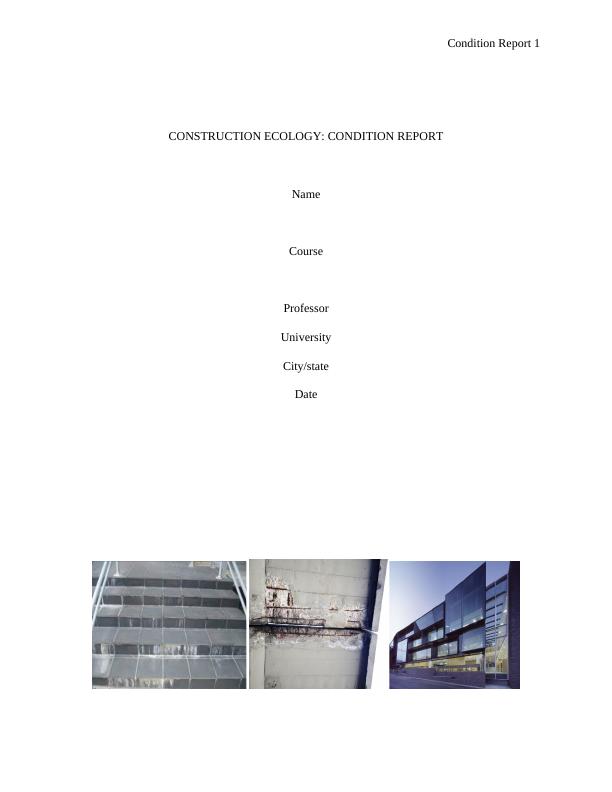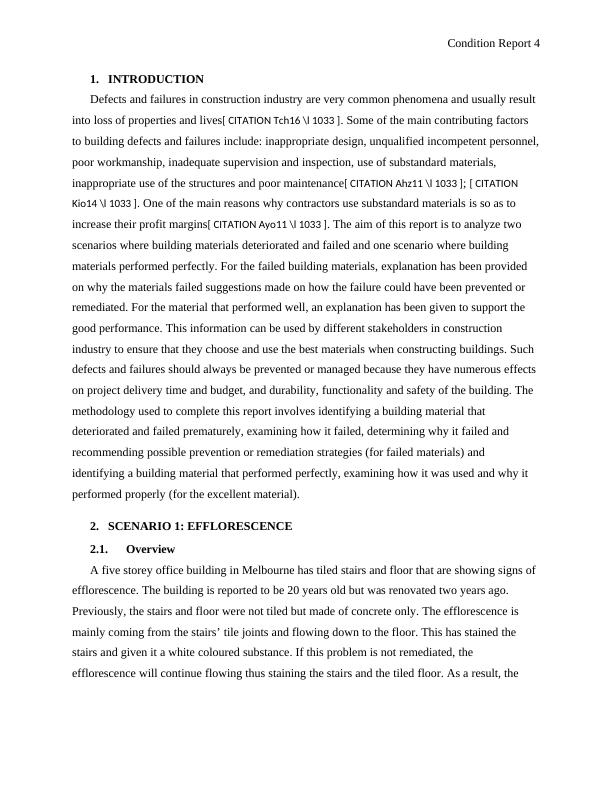Ask a question from expert
Premature decay and failure of building materials: a condition report
15 Pages3952 Words209 Views
Added on 2021-06-14
About This Document
Condition Report 1 CONSTRUCTION ECOLOGY: CONDITION REPORT Name Course Professor University Melbourne City/state Date EXECUTIVE SUMMARY This condition report presents a comprehensive analysis of three scenarios of building materials: two scenarios where building materials (efflorescence and concrete spalling) deteriorated and failed prematurely and one scenario where a building material (glass) performed exceptionally. In the first scenario, efflorescence occurred due to poor quality of cement and sand, poor workmanship of the tile installer and use of acids to
Premature decay and failure of building materials: a condition report
Added on 2021-06-14
BookmarkShareRelated Documents
Condition Report 1CONSTRUCTION ECOLOGY: CONDITION REPORTNameCourseProfessorUniversityCity/stateDate

Condition Report 2EXECUTIVE SUMMARYThis condition report presents a comprehensive analysis of three scenarios of building materials: two scenarios where building materials (efflorescence and concrete spalling) deteriorated and failed prematurely and one scenario where a building material (glass) performed exceptionally. Explanations have been given on how the two building materials deteriorated and failed, and how this could have been prevented and how it can be remediated. Also, the reasons for the superior performance of the excellent building material has been provided. The materials were selected from three different buildings. In the first scenario, efflorescence occurred due to poor quality of cement and sand, poor workmanship of the tile installer and use of acids to clean the tiles. Prevention options include use of low alkali cement and washed and clean sand, ensuring proper mix ratios of concrete, mortar and grout, quality workmanship and use of a waterproof membrane. This problem can be remediated by washing the affected surfaces, applying a suitablenon-breathable sealer on the washed surfaces, applying dense grout on tile joints, and applying a good water repellant on the tile surfaces. In the second scenario, concrete spalling occurred due to poor quality sand, inadequate concrete cover, poor workmanship and failure to apply a water repellant coat on the wall surface. Recommended prevention methods are: ensuring adequate concrete cover, use of good quality concrete materials, hiring qualified workers to ensure good workmanship, strict supervision and use of a suitable water repellant sealer on concrete surfaces. The material in the third scenario performed as intended thus there was no remediation needed.

Condition Report 3Table of ContentsEXECUTIVE SUMMARY.......................................................................................................................21.INTRODUCTION.............................................................................................................................32.SCENARIO 1: EFFLORESCENCE................................................................................................42.1.Overview.....................................................................................................................................42.2.How this happened....................................................................................................................62.3.Why this happened....................................................................................................................62.3.1.Cement................................................................................................................................62.3.2.Admixtures.........................................................................................................................62.3.3.Sand....................................................................................................................................72.3.4.Poor workmanship.............................................................................................................72.4.Prevention..................................................................................................................................72.5.Remedial Rectification..............................................................................................................73.SCENARIO 2: CONCRETE SPALLING.......................................................................................83.1.Overview.....................................................................................................................................83.2.How this happened....................................................................................................................93.3.Why this happened....................................................................................................................93.3.1.Concrete..............................................................................................................................93.3.2.Steel reinforcement..........................................................................................................103.3.3.Water repellant................................................................................................................103.4.Prevention................................................................................................................................103.5.Remedial Rectification............................................................................................................104.SCENARIO 3: GLASS....................................................................................................................114.1.Overview...................................................................................................................................114.2.Material....................................................................................................................................114.3.Appropriate use of construction materials............................................................................125.CONCLUSION/RECOMMENDATIONS.....................................................................................13REFERENCES........................................................................................................................................14

Condition Report 41.INTRODUCTIONDefects and failures in construction industry are very common phenomena and usually result into loss of properties and lives[ CITATION Tch16 \l 1033 ]. Some of the main contributing factors to building defects and failures include: inappropriate design, unqualified incompetent personnel,poor workmanship, inadequate supervision and inspection, use of substandard materials, inappropriate use of the structures and poor maintenance[ CITATION Ahz11 \l 1033 ]; [ CITATION Kio14 \l 1033 ]. One of the main reasons why contractors use substandard materials is so as to increase their profit margins[ CITATION Ayo11 \l 1033 ]. The aim of this report is to analyze two scenarios where building materials deteriorated and failed and one scenario where building materials performed perfectly. For the failed building materials, explanation has been provided on why the materials failed suggestions made on how the failure could have been prevented or remediated. For the material that performed well, an explanation has been given to support the good performance. This information can be used by different stakeholders in construction industry to ensure that they choose and use the best materials when constructing buildings. Such defects and failures should always be prevented or managed because they have numerous effects on project delivery time and budget, and durability, functionality and safety of the building. The methodology used to complete this report involves identifying a building material that deteriorated and failed prematurely, examining how it failed, determining why it failed and recommending possible prevention or remediation strategies (for failed materials) and identifying a building material that performed perfectly, examining how it was used and why it performed properly (for the excellent material). 2.SCENARIO 1: EFFLORESCENCE2.1.Overview A five storey office building in Melbourne has tiled stairs and floor that are showing signs of efflorescence. The building is reported to be 20 years old but was renovated two years ago. Previously, the stairs and floor were not tiled but made of concrete only. The efflorescence is mainly coming from the stairs’ tile joints and flowing down to the floor. This has stained the stairs and given it a white coloured substance. If this problem is not remediated, the efflorescence will continue flowing thus staining the stairs and the tiled floor. As a result, the

End of preview
Want to access all the pages? Upload your documents or become a member.
Related Documents
Material Defect Report: Spalling Concrete in Constructionlg...
|10
|2054
|343
Assessment of Building Defectslg...
|17
|4418
|59